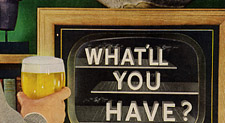 The authors of Mindless Eating: Why We Eat More Than We Think also have a little bit to say about mindless drinking – in this case wine. And it seems like the results of one study could be relevant to beer.
The authors of Mindless Eating: Why We Eat More Than We Think also have a little bit to say about mindless drinking – in this case wine. And it seems like the results of one study could be relevant to beer.
The recent story:
Forty-one diners at the Spice Box restaurant in Urbana, Illinois were given a free glass of Cabernet Sauvignon to accompany a $24 prix-fixe French meal. Half the bottles claimed to be from Noah’s Winery in California. The labels on the other half claimed to be from Noah’s Winery in North Dakota. In both cases, the wine was an inexpensive Charles Shaw wine.
Those drinking what they thought was California wine, rated the wine and food as tasting better, and ate 11% more of their food. They were also more likely to make return reservations.
It comes down to expectations. If you think a wine will taste good, it will taste better than if you think it will taste bad. People didn’t believe North Dakota wine would taste good, so it had a double curse – it hurt both the wine and the entire meal. “Wine labels can throw both a halo or a shadow over the entire dining experience,” according to Cornell Professor Brian Wansink (Ph.D.)
Wansink is Director of the Cornell Food and Brand Lab, where they do all sorts of these fun studies, including one that shows which glass shapes make us drink too much.
Think this couldn’t happen with beer?
In 1968 J. Douglas McConnell had consumers evaluate the quality of three bottles of beer over two months. Each bottle contained the same brand but drinkers were told there were three different ones priced at 99 cents, $1.20 and $1.30 per six-pack (the good old days). After repeated taste tests, consumers evaluated the highest-price brand to be of highest quality by a wide margin.
In a similar study one brand of beer was falsely labeled as four different brands, but the researches found that “all the subjects believed that the brands were different and that they could tell the difference between them.” Additionally most of the 250 participants “felt that at least one of the four brands was not fit for human consumption.”
[Both studies are cited in The U.S. Brewing Industry: Data and Economic Analysis , which is about as light-hearted a read as the title would imply.]
That research is from the 1960s and ’70s reflect the beer monoculture that prevailed when you could pick up a case of Stroh returnables for $1.99. These days we’ve got a tad more choices, but I’d still suggest you give it a little thought before grabbing your next six-pack or 750ml bottle.
More on the power of the label.
Ha ha. This is funny stuff. I’m modest enough to admit that, in a blind taste test, I’d probably embarrass myself like this. With British ale, it’s easy to tell “smoothflow” from “real ale”, but with other types of beer such as lager, the packaging and presentation does make quite a big difference. As Randy Mosher says in his book on homebrewing, the label is important, because if you don’t respect your beer enough to package it nicely, why should anyone else?